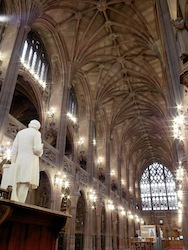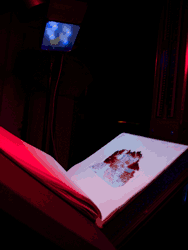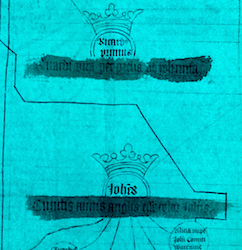We operate an ‘object centered’ digitisation approach, which means that the care of the item is at the heart of what we do. I have been working for the Library for almost 8 years now, and my job has changed dramatically through this time. I first started digitising a specific collection of approximately 22,000 Hebrew fragments from the Library’s Genizah Collection. The Library now employs 2 other photographers and an assistant, working on a variety of projects. I am project manager one day a week for an external collection from Birmingham Oratory. Working with the National Institute For Newman Studies at Pittsburg University and the Oratory, the project is to digitize the entire collection of Cardinal Newman’s archive. Rather a large job, the project is expected to last 3 years.

The Reading Room at the John Rylands Library
Over the past couple of years, we have been experimenting with Multispectral Imaging. Working closely with the team responsible for imaging the Archimedes Palimpsest, we have created a workflow using a modified camera and special lighting panels. We recently imaged a beautiful fifteenth-century French chronicle roll recording popes, emperors, kings of France and kings of England. The roll has some interesting additions and covered areas, and it was hoped we would be able to see the text under some of the erased areas.
We begin by retrieving the item from the library’s temperature and humidity controlled stores, and bring it up to our photography studios. All the team have received handling training provided by the Collection Care team, so we are generally able to assess and handle items without collection care’s input, although we do of course benefit from their expertise when imaging particularly complex or fragile items.
When carrying out the multi spectral imaging, we use a modified Phase One P45+ digital camera. This gives us images of 39 megapixel resolution. For our standard imaging we now use Phase One IQ180 cameras, which have 80 megapixels.

To use the camera for spectral imaging, we had to remove the Infrared filter from over the camera sensor. The Megavision light panels that we use emit 12 different wavelengths of light, from across the spectrum, from UV to near Infra red. Everything reacts differently when illuminated under each light source, so we are able to bring out and enhance under text.
The first thing we do is photograph a flat white surface, so we can calibrate the way the light is falling on the area to give us an even image. This is done under all 12 wavelengths. The camera is connected directly to the computer, so we can see what we are doing on screen right away. Once we have imaged the while flat surface, we can begin on the roll.
We begin in UV, which has a longer exposure time of around 10 seconds, then go through royal blue, long blue, cyan, green, amber, red, and 5 different wavelengths of infrared of 1 second exposures. (This is shown in the headline image)
Once all 12 images are captured, we can then start to look at which wavelengths give us the best results. We have been working closely with a number of colleagues and students, who are more specialized in image science. They are able to get much more advanced results. Using all 12 images, and software called imageJ, they are able to combine images and mathematically separate certain areas to enhance text. We can still get results using our own editing skills however! Especially when we are looking to show text that has been erased or covered over, full palimpsests are where it starts to get tricky!

The above image shows an area of the scroll where some of the text has been painted over. Because this has been done at a later time, and with a different ink, the older text underneath reacts differently to the light than the marking over. This image is under the green channel, and as the original ink is red, it has shown up very well with little manipulation.
These images were captured for a researcher who is interested to trace the history of the roll, and find out what areas have been added at a later date, for example a drawing of a church and King Arthur, and why certain areas have been erased. There is still lots of work to do, applying various imaging techniques to enhance the text further, and we will image the entire manuscript in visible light.
After the session is over, the roll is returned to its safe home, all of the high resolution images are stored on our university servers ready to be worked on in the future.
You can find out more about CHICC’s work at:
chiccmanchester.wordpress.com
manchester.ac.uk/library/chicc





